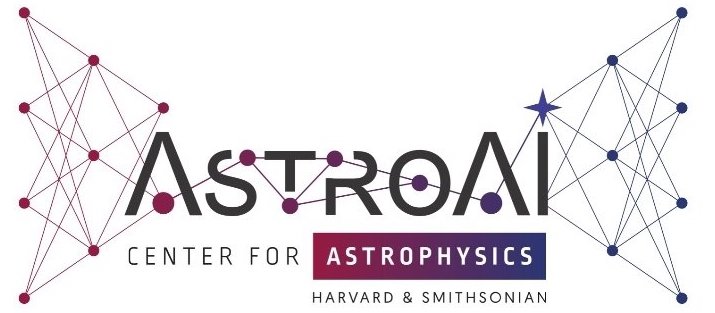AstroAI Lunch Talks - September 22, 2025 - Constança Tropa & Lea Heckmann
22 Sep 2025 - Joshua Wing
The video can be found here: https://www.youtube.com/watch?v=eXCSyMDTcqA
Speaker 1: Constança Tropa
Title: Probabilistic reconstruction of 3D peculiar velocity fields
Abstract: To study the properties of dark matter, we often turn to galaxies as a probe of the underlying matter density field. Beyond the expansion of the universe, the motions of galaxies are driven by the gravity of the surrounding structure. This peculiar velocity produces an additional Doppler shift in the observed redshift, introducing anisotropies in the clustering signal along the line of sight. If we know the peculiar velocities of the galaxies, we can correct for these redshift-space distortions and recover their positions in real space, allowing us to probe the underlying dark matter distribution more directly.
We present a framework that employs generative ML models to reconstruct these velocity fields while marginalising over parameters such as the growth rate and linear galaxy bias. Our dataset consists of 2000 QUIJOTE N-body simulations with varying cosmologies. We use normalising flows to estimate posterior distributions for Ωm, σ8, and the linear bias. We test how strongly different tracers constrain the posterior distribution, comparing summary statistics to full 3D fields, both in real and redshift space. We then make use of a diffusion model with a U-Net architecture to reconstruct velocities on small scales. Our model learns the flow that maps large-scale velocities, predicted from linear theory, onto non-linear small scales. Information on these small scales is incorporated by conditioning on the galaxy overdensity field. By sampling multiple realizations of the predicted fields, we capture the uncertainty in the peculiar motions of galaxies and therefore in their positions.
Speaker 2: Lea Heckmann
Title: Statistical and Computational Advances in Blazar Studies: Leveraging Multi-Wavelength and Multi-Messenger Data
Abstract: Blazars are prime objects to investigate in the current multi-messenger era. Even though they have been studied for decades, we are still deciphering their underlying emission and acceleration mechanisms. In this talk, I would like to introduce two projects using novel methodologies to better exploit multi-messenger data of blazars.
The first project tests whether unsupervised learning applied on multiwavelength lightcurves can identify emission states of blazars in a more unbiased way as done with current methods. Using extreme deconvolution, a Gaussian mixture model taking into account uncertainties on the input data, we test this approach on the long-term multiwavelength lightcurve of the blazar Mrk 501 and identify a range of emission states from high to low activity. Notably, we observe a distinctive relationship between radio and high-energy fluxes, suggesting the presence of multiple emission zones.
The second project aims to improve the connection between observational data with complex theoretical modeling. We are building a novel, user-friendly multi-messenger fitting approach built on the open-source package Gammapy. Our framework brings together observations from optical to very-high-energy gamma rays and operates directly on instrumental counts. However, its expansion to more complex theoretical models, such as the ones involving hadronic processes, challenges computation resources and times. To address this, we plan to explore machine learning techniques as a more efficient alternative to our current approach, which relies on parameter grids and interpolation.
